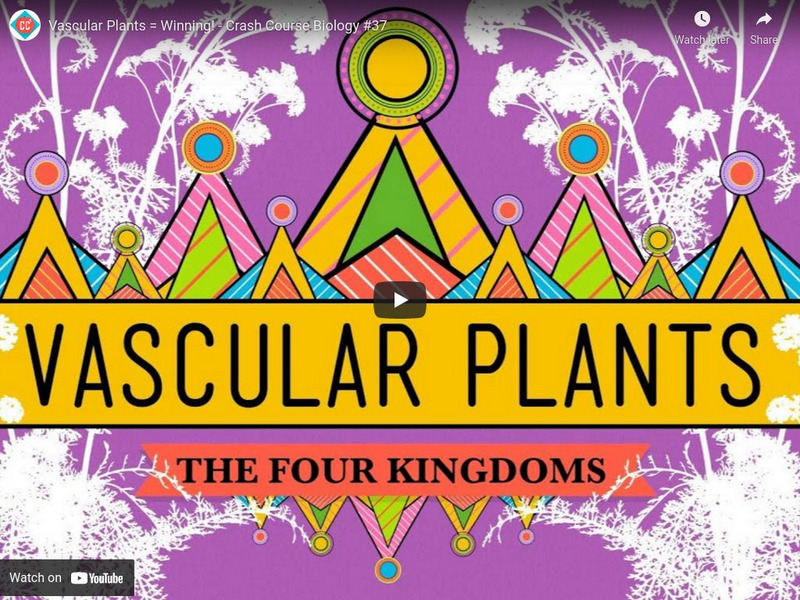Hi, what do you want to do?
MinuteEarth
Invasion of the Yellow Crazy Ants!
How much does an invasive species really matter? The video focuses on examples of accidental species spread as well as intentional introductions. It highlights the problems caused by spreading new plants and animals to areas with no...
PBS
Wind Power
Wind power blows non-renewable sources away! Why are there not more wind power plants? Science sleuths track down the reasons behind our limited use of wind energy with a video from NOVA's energy unit. The resource covers the storage and...
Fuse School
Fats and Oils (Plant Oils)
Sow the seeds of knowledge with a short video about plant oils! Science scholars discover the methods people use to extract oils from olives, coconuts, and flowers. The narrator also explains the chemical structures of these oils and why...
Nature League
Everyday Biodiversity - Field Trip
Many pupils associate biodiversity with the rain forest or coral reefs, but there is so much more to learn. Join a virtual field trip into a pharmacy to explore the importance of biodiversity in all forms. The second video in a four-part...
Crash Course
Plant Cells
Why can't plants escape prison? Because their cells were surrounded by walls. Introduce viewers to the evolution of plants with a video that discusses the differences between prokaryotic and eukaryotic cells, plant cells' organelles, and...
Teacher's Pet
Introduction to Ecology
An educational video offers an overview of ecology and discusses the levels of organization from biosphere down to organisms. It also compares terms such as habitats versus niches, generalist versus specialist, and biotic versus abiotic.
Crash Course
Community Ecology II: Predators
The first examples of mimicry we have found date back to before flowering plants. The video goes in depth on predators at the community ecology level. It includes discussions of herbivores, parasitism, adaptations, cryptic coloration,...
NASA
The Water Cycle: Heating the Ocean
There is more to the water cycle than simply rain and evaporation! The first installment in a four-part series explores the solar heating of the ocean through three satellite animations. The animations offer different views of the earth...
NASA
The Water Cycle: Following the Water
Water that leaves the oceans must eventually return. The animations in the final lesson of the four-part NASA series show the complex path water can take across landforms before returning to the ocean. Approximately one-third of the...
Khan Academy
Photosynthesis
Obtain a basic understanding of photosynthesis at a chemical level. The steps involved are introduced and simplified, but they are still challenging to understand. I suggest using this resource to supplement a lecture. An overview is...
FuseSchool
Intro to Cells: Animal, Plant, Nerve and Red Blood Cells
Throw your dendrites in the air and wave 'em like you just don't care! An excellent video in the Fuse School playlist explains the parts and functions of cells. It describes their structures, functions, and specialties.
NASA
The Water Cycle: Watering the Land
The oceans contribute 37 trillion tons of water to land masses in the form of rain and snow. The third in a four-part series from NASA show satellite animations highlighting the precipitation on Earth. The videos show the movement of the...
Periodic Videos
Thorium
Is thorium the key to future nuclear power plants? This concept and more become the focus of video 90 in the 118-part series on chemical elements. The professor shares the properties of thorium as well as the future possibilities of a...
Fuse School
Quarrying - Economic, Environmental and Social Effects
Where does limestone actually come from? The sixth video in a seven-part series introduces pupils to the quandary of quarrying. The resource examines the positive economic factors involved in digging for limestone, as well as the...
Howard Hughes Medical Institute
The Day the Mesozoic Died
A dynamic, three-part feature explores what caused mass extinction of the dinosaurs at the end of the Cretaceous period. Computer animations, interviews, and on-site footage from around the world divulge evidence that it was the K-T...
Curated OER
Trees
Trees are one of the most amazing life forms on the planet. Learn about the wonders, life cycles, and parts of trees. This is a beautiful and informative clip that will provide learners with a respect and understanding of why trees are...
MinuteEarth
Why Does Earth Have Deserts?
Deserts make up 33 percent of the land surface area on the earth, so why does Earth have them? The video explains the wind and weather patterns that lead to deserts as well as rain forests. It details how this is related to the ocean...
SciShow
Wasp Nests and Bee Hives
It turns out that wasps and bees have a lot more in common that the word ouch! Junior entomologists explore the similarities and differences between flying, stinging insects with the 136th installment in a 143-part series of science...
Nature League
What Are Adaptations? - Lesson Plan
Texas short-horned lizards shoot blood out of their eyes to deter predators. The unique adaption allows them to thrive in a hostile environment. Pupils learn more about this and other adaptations of plants, animals, and humans in the...
Khan Academy
First Living Things on Land Clarification, Cosmology and Astronomy
Sal clarifies concepts covered in the Khan Academy video on Biodiversity in the Phanerozoic Eon. He explains the types of animals and plants that were the first life forms on land. Additionally, he describes what these organisms would...
CK-12 Foundation
Ck 12: Plant Cell Structures: Parts of a Plant Cell
[Free Registration/Login may be required to access all resource tools.] Take a tour of a plant cell and see how they differ from animal cells. Also take a look at the unique characteristics that some plants have. [2:57]
Crash Course
Crash Course Biology #37: Vascular Plants = Winning!
Hank introduces us to one of the most diverse and important families in the tree of life - the vascular plants. These plants have found tremendous success and the their secret is also their defining trait: conductive tissues that can...
Science Friday Initiative
Science Friday: Finding the Roots of an Ancient Crop
Agave plants, probably best known as the source of tequila, were important as a food crop long before the invention of margaritas. Wendy Hodgson, botanist at the Desert Botanical Garden in Phoenix, says the plants were cultivated as far...
PBS
Pbs News Hour: Here's What Contributed to the Extinction of the Ivory Billed Woodpecker
The U.S. Fish and Wildlife Service proposed moving 23 animals and plants off the endangered species list, declaring them extinct. Perhaps the most well-known of the species deemed gone forever is the ivory-billed woodpecker. These...




























